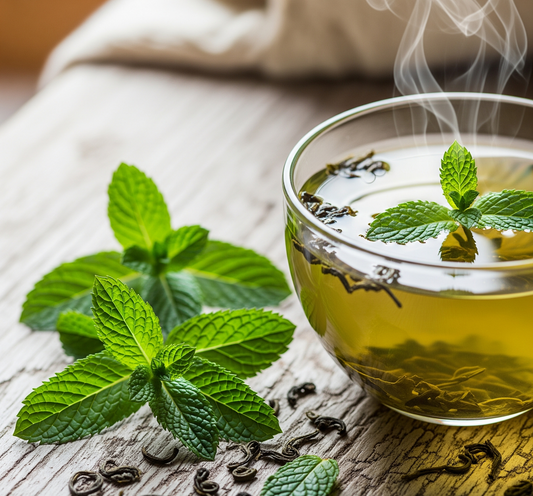The most consumed beverage in the world after water, tea is enjoyed by millions of people and enjoyed in range of flavors and aromas. An array of infusions and blends that go beyond traditional teas are loved by tea drinkers today. All of them have a special place in the tea world. However, not all teas are made equal.
There is a distinction: Some teas are true teas, and some beverages known to be teas are in fact tisanes. If you've never heard of teas versus tisanes before, we'll give you a comprehensive guide to the tea basics, explaining the differences between true teas and tisanes.
The Legend of True Teas:
Tea drinking culture has been documented in the world as early as 10th century BC in mythological writing, ancient medicinal texts as well ancient trade records. According to Chinese tea legend, it was Emperor Shennong who discovered tea leaves.

A tea plantation in Ancient China. Source: wikicommons
Emperor Shennong was a venerated patron saint of farmers, traders, and traditional Chinese medicine in ancient Chinese lore. Regarded as a deity, he experimented with various herbs and flowers with medicinal properties on his own body, sometimes even poisoning himself and restoring his health by the use of antidotal, medicinal teas.

Mythical Emperor Shennong. Source: Wikicommons
It was this Emperor who is credited to the discovery of tea. One day, while boiling water in his garden, a leaf from a nearby tea tree fell into the pot of water. Intrigued by the unique aroma and color of the brew, and accustomed to experimenting with new herbs and leaves, the Emperor took a hearty sip of this tea.
This brew's unique taste and restorative properties has been embedding into Chinese cultures since, and has now spread all over the world, becoming a mainstay of cultures around the world.
Why did true tea originate in China?
All true teas, distinct from tisanes that are created from a mix of herbs, spices and florals, come from the same plant: Camellia Sinensis.
Camellia Sinensis is a fascinating plant in its own right. Native to East Asia, this plant is said to have originated in southwestern China and northern Myanmar, which is why tea as a medicinal and restorative drink was a southern Chinese practice until the mid-8th century, when the Tang Dynasty came into power. During this period, tea spread across the nation in the form of tea-bricks, used as currency in trading, especially in regions where the coin lost its value.
The practice of drinking tea, as well as cultivating and processing tea, spread from China to Japan and Korea through the hands of Buddhist monks travelling across Asia. Deeply tied to spirituality and the veneration of spirit and purification of the body, the tea culture in these regions were deeply tied to rites and rituals of honor.
Camellia Sinensis in the present:
Tea culture has evolved several times over in its journey to the present. It has spread across the world and has evolved to suit drastically different cultures. With the evolution of tea culture, the tea plant Camellia Sinensis has also evolved to suit different climates and terroirs, branching into two varietals and an astounding variety of cultivars, all with their own unique characteristics.

Leaves plucked from different varietals and cultivars undergo various processing methods, each yielding distinct types of tea. The most well-known categories of true teas include black tea, green tea, white tea, oolong tea, and pu-erh tea. The intricate variations arise from differences in oxidation, rolling, and firing techniques.
When did Tisanes come into the picture?
Lovers of true teas sometimes have a bone to pick with the prevalence of tisane brews being consumed under the guise of teas. This is more than just a pedantic gripe of a true tea connoisseur, as tisanes have their own history, benefits and cultural significance.

Used for centuries in Ayurvedic practices of South Asia -- India, Sri-Lanka and Nepal -- as well as Ancient Greece, Egypt and China, tisanes are more commonly touted for their medicinal properties. Various tisanes are also indispensable in traditions and indigenous rituals.
The world Tisane originates from the Greek word ptisanē, which is a drink made from pearl barley. Today, tisanes encompass herbal brews concocted from various fruits, herbs, spices, and plant parts such as leaves or roots. They are often caffeine-free infusions, and provide an aromatic, sensory experience often offering health benefits.
Unlike teas, tisanes don't originate from the Camellia sinensis plant and can be grouped into different categories based on the blend. Herbal blends like tulsi, ginger, and mint are popular in ayurvedic medicine. Spice blends feature cinnamon, turmeric, cardamom, star anise, to name a few. Fruit blends are tisanes with dried fruits like apples and berries, while botanical blends use dried rose petals, elderflowers, lavender, chrysanthemum, and chamomile.
True tea and Tisane: How to tell the difference?
If you've read this far, you can already tell whether the teas in your pantry are mostly true teas, or if they are mostly tisanes. Here's a quick summary of the key differences:
1. Source: Teas originate exclusively from the tea plant, while tisanes encompass a wide range of plant-based ingredients.
2. Caffeine Content: Teas naturally contain caffeine, whereas tisanes are caffeine-free unless blended with tea leaves.
3. Flavor Spectrum: Teas encompass a broad spectrum of flavors, influenced by processing methods, while tisanes derive their flavors from the botanicals used.
4. Health Benefits: Teas are often praised for their potential health advantages due to compounds like catechins and antioxidants. Tisanes offer diverse benefits based on their botanical ingredients.
Conclusion:
While teas are born from the Camellia sinensis plant and encompass a rich variety of flavors, tisanes are captivating infusions crafted from herbs, fruits, spices, and more. Exploring both realms offers a tantalizing journey into the art of brewing and savoring their unique histories, cultural aspects and benefits.




